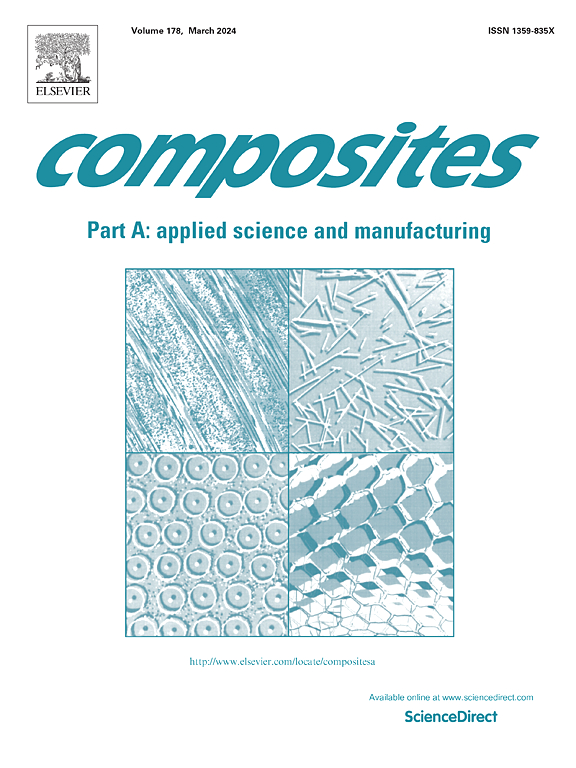A multifunctional epoxy composites based on cellulose nanofiber/carbon nanotube aerogels: Simultaneously enhancing fire-safety, thermal conductive and photothermal performance
IF 8.1
2区 材料科学
Q1 ENGINEERING, MANUFACTURING
Composites Part A: Applied Science and Manufacturing
Pub Date : 2024-10-09
DOI:10.1016/j.compositesa.2024.108514
引用次数: 0
Abstract
As 5G technology develops and electronic power density increases, preparing epoxy resin (EP) composites with excellent fire-safety, thermostability, and thermal conductivity remains challenging. Herein, hexaphenoxy cyclotriphosphazene and poly(piperazine methylphosphonic acid pentaerythritol ester) were used as synergistic flame retardants (FR) for EP. The cellulose nanofiber/carboxylated multiwalled carbon nanotubes aerogels (CCA80) were prepared and immersed into the EP and FR mixture to obtain EP/CCA80/FR composites. Compared with neat EP, the limiting oxygen index of EP/CCA80/6 wt% FR increased by 38.9 %, the total heat release and CO2 production rate decreased by 30.61 % and 39.47 %, respectively, achieving the UL-94 V-0 rating. Moreover, its thermal conductivity was 1.06 W · m−1·K−1, 457.9 % higher than neat EP, while maintaining excellent electrical insulation. Its surface temperature maintained at 94.5 °C under 1.0 kW·m−2 irradiation for 2 h, exhibiting good photothermal conversion capability and photobleaching resistance. A novel fabrication methodology of multifunctional EP composites for high-performance electronic component was proposed.
基于纤维素纳米纤维/碳纳米管气凝胶的多功能环氧树脂复合材料:同时提高防火安全、导热和光热性能
随着 5G 技术的发展和电子功率密度的增加,制备具有出色的防火安全性、热稳定性和导热性的环氧树脂(EP)复合材料仍具有挑战性。在此,六苯氧基环三膦苯和聚哌嗪甲基膦酸季戊四醇酯被用作 EP 的协同阻燃剂(FR)。制备了纤维素纳米纤维/羧基多壁碳纳米管气凝胶(CCA80),并将其浸入 EP 和 FR 混合物中,得到 EP/CCA80/FR 复合材料。与纯 EP 相比,EP/CCA80/6 wt% FR 的极限氧指数提高了 38.9%,总热量释放率和二氧化碳产生率分别降低了 30.61% 和 39.47%,达到了 UL-94 V-0 级标准。此外,它的导热系数为 1.06 W-m-1-K-1,比纯 EP 高 457.9%,同时保持了优异的电绝缘性。在 1.0 kW-m-2 照射下 2 小时,其表面温度保持在 94.5 ℃,表现出良好的光热转换能力和抗光漂白能力。提出了一种用于高性能电子元件的多功能 EP 复合材料的新型制造方法。
本文章由计算机程序翻译,如有差异,请以英文原文为准。
求助全文
约1分钟内获得全文
求助全文
来源期刊

Composites Part A: Applied Science and Manufacturing
工程技术-材料科学:复合
CiteScore
15.20
自引率
5.70%
发文量
492
审稿时长
30 days
期刊介绍:
Composites Part A: Applied Science and Manufacturing is a comprehensive journal that publishes original research papers, review articles, case studies, short communications, and letters covering various aspects of composite materials science and technology. This includes fibrous and particulate reinforcements in polymeric, metallic, and ceramic matrices, as well as 'natural' composites like wood and biological materials. The journal addresses topics such as properties, design, and manufacture of reinforcing fibers and particles, novel architectures and concepts, multifunctional composites, advancements in fabrication and processing, manufacturing science, process modeling, experimental mechanics, microstructural characterization, interfaces, prediction and measurement of mechanical, physical, and chemical behavior, and performance in service. Additionally, articles on economic and commercial aspects, design, and case studies are welcomed. All submissions undergo rigorous peer review to ensure they contribute significantly and innovatively, maintaining high standards for content and presentation. The editorial team aims to expedite the review process for prompt publication.
 求助内容:
求助内容: 应助结果提醒方式:
应助结果提醒方式:


